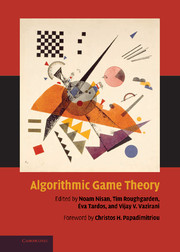Book contents
- Frontmatter
- Contents
- Foreword
- Preface
- Contributors
- I Computing in Games
- II Algorithmic Mechanism Design
- III Quantifying the Inefficiency of Equilibria
- IV Additional Topics
- 22 Incentives and Pricing in Communications Networks
- 23 Incentives in Peer-to-Peer Systems
- 24 Cascading Behavior in Networks: Algorithmic and Economic Issues
- 25 Incentives and Information Security
- 26 Computational Aspects of Prediction Markets
- 27 Manipulation-Resistant Reputation Systems
- 28 Sponsored Search Auctions
- 29 Computational Evolutionary Game Theory
- Index
29 - Computational Evolutionary Game Theory
from IV - Additional Topics
Published online by Cambridge University Press: 31 January 2011
- Frontmatter
- Contents
- Foreword
- Preface
- Contributors
- I Computing in Games
- II Algorithmic Mechanism Design
- III Quantifying the Inefficiency of Equilibria
- IV Additional Topics
- 22 Incentives and Pricing in Communications Networks
- 23 Incentives in Peer-to-Peer Systems
- 24 Cascading Behavior in Networks: Algorithmic and Economic Issues
- 25 Incentives and Information Security
- 26 Computational Aspects of Prediction Markets
- 27 Manipulation-Resistant Reputation Systems
- 28 Sponsored Search Auctions
- 29 Computational Evolutionary Game Theory
- Index
Summary
Abstract
This chapter examines the intersection of evolutionary game theory and theoretical computer science. We will show how techniques from each field can be used to answer fundamental questions in the other. In addition, we will analyze a model that arises by combining ideas from both fields. First, we describe the classical model of evolutionary game theory and analyze the computational complexity of its central equilibrium concept. Doing so involves applying techniques from complexity theory to the problem of finding a game-theoretic equilibrium. Second, we show how agents using imitative dynamics, often considered in evolutionary game-theory, converge to an equilibrium in a routing game. This is an instance of an evolutionary game-theoretic concept providing an algorithm for finding an equilibrium. Third, we generalize the classical model of evolutionary game theory to a graph-theoretic setting. Finally, this chapter concludes with directions for future research. Taken as a whole, this chapter describes how the fields of theoretical computer science and evolutionary game theory can inform each other.
Evolutionary Game Theory
Classical evolutionary game theory models organisms in a population interacting and competing for resources. The classical model assumes that the population is infinite. It models interaction by choosing two organisms uniformly at random, who then play a 2-player, symmetric game. The payoffs that these organisms earn represent an increase or a loss in fitness, which either helps or hinders the organisms ability to reproduce.
- Type
- Chapter
- Information
- Algorithmic Game Theory , pp. 717 - 736Publisher: Cambridge University PressPrint publication year: 2007
- 5
- Cited by



